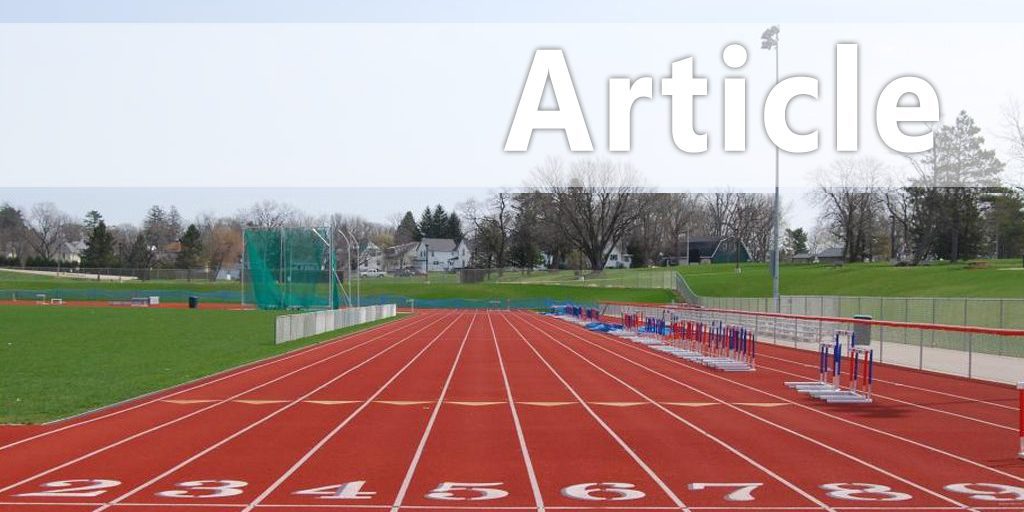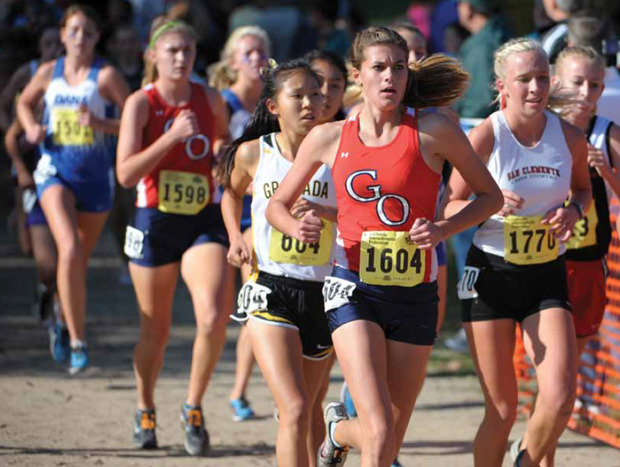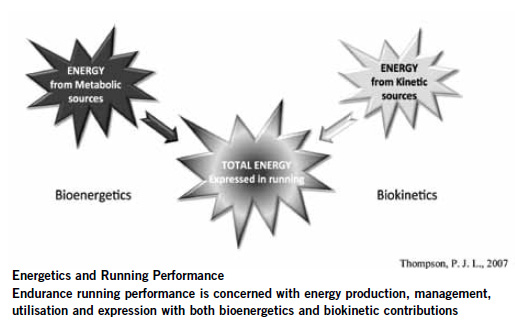| Growing Pains: The Effects of the Adolescent Growth Spurt on Biokinetic Energy Production and Middle Distance Performance |
| By: Peter Thompson
Originally Published in: Techniques Magazine - Provided by: USTFCCCA
THE ELEPHANT IN THE ROOM The four of them stood somewhat awkwardly together at the end of the cross-country race, the coach, the father, his wife and their daughter, the young athlete we'll call Liz. The father looked at his daughter and said, "I don't know what's the matter with you but last year you were easily beating all of these girls and now they're beating you and you're just not trying. I just can't understand it. Your mother and I do everything to support your running. We take you to training and to competitions but if you're not going to even try, what's the point." Liz studied intently the muddy grass at her feet, unable or unwilling to respond to her father's comments. This was not the first time that this theme had been uttered in public in the preceding weeks and it had been touched on with greater vehemence in private, at home. The coach tried to intervene by mentioning, again, the fact that Liz had gone through a considerable growth spurt in the previous 12 months. "I don't want to hear excuses. She hasn't grown that much and surely longer legs should mean that she can run faster. She's just not trying hard enough." And, with that comment from the father, the parents departed, leaving their daughter to run freely and cool down with the other members of her team. They, at least, were supportive and the coach had taught them all well what to expect as they each made their journey physically, mentally and socially through puberty and adolescence. The coach had her focus on the process, the father's, purely on the outcome. A week later, the coach received a phone call from the athlete's mother. "I have to apologize. Last week when you said that Liz had grown a lot, we were not really aware of this and by how much. I've checked and in the past 12 months she has grown six inches and is 20 pounds heavier." No wonder then, that Liz was having problems emulating her previous year's performance. But, exactly what factors were causing the decreased performance? These conversations are fiction of course but, unfortunately, variations on this theme are played out within families each and every year. There is always a very individualized response to the adolescent growth spurt but there are common contributors to performance at any age. We can identify these and then throw that knowledge against how the individual is impacted in any given area. If we look at the simplest contributor to performance, it is how the athlete creates, manages, utilizes and expresses energy. The energy for middle and long distance performance derives from two principal sources, metabolic, or bioenergetics, sources and elastic, or biokinetic sources. Coaches have long concentrated on the metabolic development of their athletes but have, until relatively recently, not recognized and therefore paid less attention to the biokinetic contribution. Many still have too great a focus on training the metabolic energy systems of their athletes, ignoring biokinetic development, as an equal and powerful, metabolic energy-sparing contributor. In this article we will focus on the effects of the adolescent growth spurt, AGS, on biokinetic energy production and middle distance performance. We know that biokinetic energy comes principally from the stored elastic energy of tendons and the fascia surrounding the muscles. Together, these structures are capable of providing an energy-return system, the efficiency of which is determined by the stiffness of the lower kinetic chain. We will come back to exactly what this "stiffness" is but it crucially defines performance. The dramatic improvements and achievements of athletes such as Jenny Simpson, Galen Rupp, Paula Radcliffe and Mo Farah can be ascribed in large part to the appropriate development of the contribution from their elastic capacities. This development of optimal stiffness has turbo-charged their vVO2max, tlimvVO2max, running economy and performance. What has not been really examined previously is, "What is the effect, or potential effect, of the adolescent growth spurt on stiffness and biokinetic energy production?" GROWTH AND MATURATION Now, every single one of you reading this article knows that during puberty and adolescence the body normally goes through distinct stages including a considerable growth spurt. The adolescent growth spurt, AGS, varies by gender, with different timing of onset and rates of growth. On average, girls between 10 and 16 will grow 8 inches and gain 38 pounds; boys between the ages of 12-16 will grow an average of 12 inches and gain close to 48 pounds. If we look at the averages again, the first sign of puberty in girls occurs at 10-1/2 years of age, with breast development. The first period or menarche is at an average age of 12-13 years, and usually occurs about two years after puberty begins. This coincides with their peak in height velocity, the adolescent growth spurt, AGS. Once the ovaries are mature, the legs have generally finished growing. Any increase in height after periods have begun, usually comes just from the torso, as the spine grows. Development continues and a child will have reached her final adult height about two years after menarche as, lastly, the bones of the pelvis widen and become smooth, in preparation for childbirth. This can occur up to the age of 18 or even later. Puberty generally begins later in boys, on average at 11-1/2 to 12 years of age and they undergo their AGS about 2-3 years later than girls. The AGS usually begins at the distal areas, with an enlargement of the hands and feet and is later followed proximally, by growth in the legs and arms, then trunk and chest, for boys or hips, for girls. This growth pattern even follows a distal to proximal progression within the limbs, with the shin bones lengthening before the thigh and the forearms before the upper arms. And, for all parts of the body bones grow slightly ahead of muscles, tendons and fascia. This has profound effects on coordination, skill and stiffness. For both girls and boys there is tremendous individual variation in the timing of physical development. One standard deviation (68 percent of any population) away from the normal has been stated as plus or minus two years for the AGS and two standard deviations (embracing 95 percent of any population) would be plus or minus four years. This means that we could have a boy or girl who is 14 by their birth age but physically be anywhere from 10 to 18 years of age. For 95 percent of the population, the AGS takes place in a range of 9 to 17 years of age for girls and 11 to 19 years of age for boys. Adolescents who are developmentally away from the average in their physical development are identified as "early" or "late" developers. In athletics, the power events usually attract the early developers and cross-country and the longer running events, the late developer. The 800m and 1500m fall in between and we see both early and late developers performing well as children and through adolescence. Many times the early developers "'flatter to deceive" and fail to make the progress that their early performances indicate. Late developers, however, have the advantages of the androgynous body type of the pre-pubescent child until mid to late teens but then the AGS will still affect performance. THE IMPACT OF THE AGS Boys have a performance advantage through puberty since they gain height and muscle mass and testosterone stimulates greater production of hemoglobin, leading to an increased oxygen-carrying capacity. Girls gain height but also a relatively higher percentage of body fat. But for both boys and girls running performance is impacted by the AGS through the well-known factors of loss of coordination and biomechanical efficiency, low energy levels, increased weight, decreased power to weight ratio, decreased functional VO2 max and for girls the additional changing biomechanics, as the hips broaden. The rapid growth also impacts the body's ability to control stiffness as the athlete loses the skill of running, if they had it, and this includes the ability to adapt to the running speed or surface to create and utilize elastic energy.
At its simplest, running is based on propelling the body forward while the body tries to keep its center of gravity level during the running cycle. During impact with the ground, the leg acts much like a spring, absorbing energy and releasing it later in the running cycle. The closer the 'stiffness' of the spring is to optimal, the better the elastic return and the less metabolic energy you will need to run at a certain speed, or the faster you can run for the same metabolic contribution. To give you an example of this stiffness, think about what would happen if you were to run gently across a concrete parking lot at the beach and continue straight onto the sand. What would happen? Most probably, when you hit the sand your legs would remain extended to a much greater degree at each joint than they were while running over the parking lot. In other words, your legs would be stiffer on the sand. The stiffness of the leg is a function of the lower kinetic chain involving the hip, knee, ankle and foot joints and the connective tissues, tendons and fascia. If you were to sprint across the concrete on to the sand, you may well stumble and fall, as the legs do not have time to adjust to the new soft and giving surface. Usually the body adapts and leg stiffness will relatively increase on softer surfaces and will decrease on harder surfaces. Incorrect stiffness produces negative results in either direction. If the lower elastic energy is dissipated, lost, in the impact. If the stiffness is not sufficient then the energy is dissipated, lost, into the squidgy spring and another consequence is that the muscles will have to activate more, use more metabolic energy. There has recently been a re-evaluation of the "stretch-shortening cycle" or SSC and its role in biokinetic energy production. The old view of the elastic properties of the lower kinetic chain was to imagine an active SSC, with the muscle-tendon system acting as a rubber band. While loading and stretching it, energy would be stored (eccentric phase) in the muscle and this energy would be regained at shortening (concentric phase) for toe-off. The current view is that the eccentric contraction phase of the muscle is not so important as the elastic properties of the tendon and muscle fascia. The muscle now needs to be emphasized as being in isometric mode all through our movement and drills. This is essentially the same rubber band analogy except there is a recognition that the muscle response and contribution is not as great as it was thought to be for creating force but is vital as a stabilizer and resistance. The rubber band is now the tendon and the muscle fascia and the most energy will be regained if the stiffness is optimal. The level of isometric stabilization by the muscles and positioning of the joints determines the stiffness of the system. For all adolescents, boys and girls alike, there is a negative impact on stiffness during the AGS from the changes to the hardware, the skeleton, muscles and connective tissues. But, girls have the added factor of changes to non-contributing body weight. For girls, the adaptations required during and after the AGS before they recapture their full biokinetic, elastic energy capacities generally takes much longer. WHAT CAN BE DONE? Many of the things that you're prob-ably already doing can assist the passage through the AGS and do help in regaining elastic power but, now, you can perhaps see a different, or shift, in emphasis and different options. Looking at research seems to tell us very little since most studies look at preadolescent compared to post adolescent subjects and performing jumping activities. Since the timing of the AGS is so individualized you would have to perform a longitudinal study over many years to obtain data on what is happening to stiffness during any given individual's AGS. The results of one study indicated that young children have insufficient stiffness. Another speculated, "that during adolescence, children acquire the ability to take greater advantage of elastic energy storage in the musculotendinous system when performing jumps." But let's look at what we know intuitively and from our new knowledge of the role of stiffness. To be effective, the coach of adolescents must have some sense of the biological development of each of their athletes and take an individualized approach rather than a "group" approach. But within any group you can occasionally develop subgroups based on varying criteria, dependent on the activity, such as socio-mental maturation, physical maturation, competitive level or, simply, height. Encourage and model healthy eating habits for all. Too many girls experience negative body image in adolescence and try to halt the healthy weight gains of the AGS, or even reverse it. But, an eating disorder typically helps an athlete maintain or improve performance as a runner for about six months. Then, the consequences are inevitable and disastrous. An eating disorder often leads to amenorrhea, the absence of menstruation. Amenorrhea decreases bone density. Low bone density leads to stress fractures and osteoporosis and a destructive downward spiral that leads to a fragile skeleton for life. The emphasis for both boys a girls through the AGS is to maintain a healthy lean body mass. Introduce at an early age, sessions that develop awareness of correct, natural, neutral posture to be continued during the AGS. Without correct posture the kinetic chains are unlikely to ever be in a position to function optimally. Novel and new coordination movements should be introduced along with the continued practice and re-learning of previous skills and coordination. Since all of these activities require learning and re-learning, fatigue should not be allowed to be a factor in the session. For a great resource for exercises for developing posture and optimal stiffness refer to Jay Dicharry's 2012 book, "Anatomy for Runners." Educate the athletes that frequency and variety is better than quantity. "More" training rarely equals "better" training We know that stiffness in running is a function of speed of running, shoe softness, surface softness and terrain. In all these areas there should be variety and more, variety. Change the paces and never jog, either walk or run from easy to faster. Use a variety of shoe models and brands and run on differing surfaces and terrain. Outside of running, use multi-lateral movements and different, particularly glute-dominant, movement patterns in cross-training and through taking part in other sports, while not losing the athletes to these other sports! Strength needs to be developed to handle the new, increased body weight and this should be developed within functional body movements. What else can you do through the AGS? Encourage getting sufficient, uninterrupted sleep. Use an empathetic, process-oriented, non-comparison model of coaching. Motivate to maintain the physical activity when what was once easy becomes tough. Be honest — particularly on the possible time it will take to recover performance levels. Encourage patience and have patience. Respect their socio-mental development as well as their physical development. Be aware of the athlete's susceptibility to training injuries, especially during and immediately after AGS. It can take some athletes many years to recover prior-AGS performance levels and for some there is barely a change in progression. When we see an athlete who loves the sport enough to continue and at age 25 finally surpasses her best from age 15, we know that perseverance has been rewarded and we have all see this happen. While the AGS appears to rob athletes of their ability, a good young athlete will usually develop into a good adult athlete, particularly the late developers, provided they regain and further develop the natural "spring" of their preadolescent youth. REFERENCES Dicharry, J. (2012) Anatomy for Runners: Unlocking Your Athletic Potential for Health, Speed and Injury Prevention. Skyhorse Publishing, New York, USA Greene, L. and Pate, R. (2015) Training Young Distance Runners, Third Edition. Human Kinetics, Champaign, IL, USA Korff, T., Home, S. L., Cullen, S. J. and Blazevich, A. J. (2009) Development of lower limb stiffness and its contribution to maximum vertical jumping power during adolescence. The Journal of Experimental Biology 212, 3737-3742 Wang, G, L-I., Lin, D-C. and Huang, C (2004) Age Effect on Jumping Techniques and Lower Limb Stiffness During Vertical Jump. Research in Sports Medicine 12: 209-219. Peter Thompson was the IAAF Event Group Editor for the Endurance events and European ACA Leader for Endurance from 2007-2011. He lives and coaches in Eugene, Oregon. |








